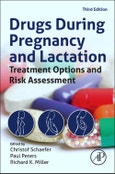Drugs During Pregnancy and Lactation, Third Edition is a quick and reliable reference for all those working in disciplines related to fertility, pregnancy, lactation, child health and human genetics who prescribe or deliver medicinal products, and to those who evaluate health and safety risks. Each chapter contains twofold information regarding drugs that are appropriate for prescription during pregnancy and an assessment of the risk of a drug when exposure during pregnancy has already occurred. Thoroughly updated with current regulations, references to the latest pharmacological data, and new medicinal products, this edition is a comprehensive resource covering latest knowledge and findings related to drugs during lactation and pregnancy.
Please Note: This is an On Demand product, delivery may take up to 11 working days after payment has been received.
Table of Contents
1. General Commentary on drug therapy and drug risks in pregnancy2. Specific drug therapties during pregnancy
2.1 Analgesics, non-steroidal anti-inflammatory drugs (NSAIDs), muscle relaxants, and antigout medications
2.2 Allergy and hyosensitization therapy
2.3 Antiasthmatic and cough medication
2.4 Nausea and vomiting in pregnancy
2.5 Gastro-intestinal medications, hyoplipidemic agents and spasmolytics
2.6 Anti-infective Agents
2.7 Vaccines and immunoglobulins
2.8 Heart and blood medications
2.9 Anticoagulants, thrombocyte aggregation inhibitors, fibrinolyrics,and volume replacement agents
2.10 Epilepsy and antiepileptic medications
2.11 Psychotropic drugs
2.12 Immunosuppression, rheumatic diseases, multiple sclerosis, and Wilson's disease
2.13 Antineoplastic drugs
2.14 Uterine contraction agents, tocolytics, vaginal therapeutics and local contraceptives
2.15 Hormones
2.16 General and local anesthetics and muscle relaxants
2.17 Dermatological medications and local therapeutics
2.18 Vitamins, minerals and trace elements
2.19 Herbs during pregnancy
2.20 Diagnostic agents
2.21 Recreational drugs
2.22 Poisonings and toxins
2.23 Occupational, industrial and environmental agents
3. General commentary on drug therapy and drug risk during lactation
3.1 The advances of breastfeading versus the risks of maternal medication
3.2 The passage of medication into the mother's milk
3.3 Infant characteristics
3.4 Milk plasma ratio
3.5 Amount of medication in the milk and relative dose
3.6 Toxicity of medications in the mother's milk
3.7 Medications that affect lactation
3.8 Breastfeeding support
4. Specific drug therapies during lactation
4.1 Analgesics, antiphlogistics and anesthetics
4.2 Antiallergics, antiasthmatics and antitussives
4.3 Gastrointestinal drugs
4.4 Anti-infectives
4.5 Vaccines and immunoglobulins
4.6 Cardiovascular drugs and diuretics
4.7 Anticoagulants, thrombocyte aggregation inhibitors and fibrinolytics
4.8 Antiepileptics
4.9 Psychotropic drugs
4.10 Immunomodulating and antineoplastic agents
4.11 Hormones and hormone antagonists
4.12 Dermatological medication and local therapeutics
4.13 Alternative remedies, vitamins, and minerals
4.14 Contrast media, radionuclides and diagnostics
4.15 Infections during breastfeeding
4.16 Recreational drugs
4.17 Plant toxins
4.18 Industrial chemicals and environmental contaminants
4.18.1 Persistent organochlorine compounds (pesticides, polychlorinated biphenyls and dioxins)
4.18.2 Mercury
4.18.3 Lead
4.18.4 Cadmium
4.18.5 Other contaminants
4.18.6 Breasfeeding despite environmental contaminants?
4.18.7 Breastfeeding and the workplace








